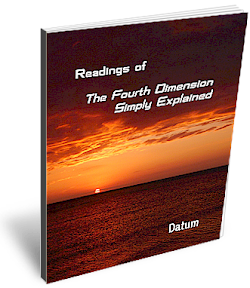The judge in charge to select the best articles was Dr. Henry Parker Manning (1859-1956), a mathematics professor at Brown University. Manning was a specialist in non-traditional geometries and algebras like non-Euclidean geometry and quaternions.
One of the rules of the contest was that the articles should not be greater than 2500 words; thus the essays were going be medium sized in length. Another rule was that the essays should be submitted with pseudonyms instead of the true author name. Since each author was writing independently of the others, and from different countries, some repetitions in concepts were inevitable.
 |
| Readings of The Fourth Dimension Simply Explained |
Reproduced below is the discussion of Manning about what should be a wheel in four-dimensional space.
A wheel of four-dimensional matter, in two dimensions of the shape of a circle and in the other two dimensions very small, would have for axis a flat plate instead of a rod. This axial plate could extend indefinitely in all the directions of its plane without any interference with the wheel. The wheel can slip all around over the axial plate unless held to some position on it, just as with us a wheel may slip along on its axis unless held to some position on it. We may suppose that in a three-space we can see the axial plate and a pair of opposite radii (spokes) of the wheel, appearing to us entirely separate; in this way we can see a two-dimensional hole. Or we can see the entire wheel with a hole through it and an axial rod, cut from the axial plate by our three-space.Manning included no figures to clarify his ideas, but we can suppose that what he did is that in the same way that a line (an axis) projected into the next dimension would produce a plane, he deduced that an axis holding two wheels, when projected into the next dimension would become a plane. It is not easy to visualize two linked rotating wheels in 4D where their common axis is a plane, but anything about the fourth dimension is not easy.
But Manning goes further and writes:
We can fasten the wheel rigidly to the axial plate so that it will turn with the wheel, the wheel turning in its plane and the plate turning on itself. We may put more than one wheel on an axial plate, putting different wheels at different points on the plate wherever we please. If these wheels are all fastened rigidly to the axial plate we turn them all by turning one. Thus we have a method of constructing machinery in space of four dimensions.If this is not enough to dazzle your mind, wait until you read this:
The axial plate may itself be a wheel. We may fasten two wheels together at their centers making them absolutely perpendicular to each other. Such a figure can revolve in two ways, the plane of one wheel being the axis plane of the rotation and the plane of the other wheel the rotation plane.Dr. Manning should be speaking from a strictly mathematical point of view; he cannot be fantasizing about higher dimensions. However in the past article The strange extraterrestrial worlds of Camille Flammarion, in the paragraphs about the controvertible Flammarion's woodcut, I called to the attention to the enigmatic solid wheel that appears at the top of the "woodcut" (the woodcut figure is repeated here). Note how in this woodcut, the two intersecting wheels are drawn like two classic ox cart wheels. Possibly, when the artist carved this --let's call it, cross-wheel, or super-wheel-- he was not thinking about a fourth dimension, he needed not to. What he tried to convey was the idea that beyond the spheres that limit our imagination many things can coexist even when they appeared to be contradictory to our senses. Hence, for this artist, wheels that can move in two directions simultaneously are possible. Manning, speaking without the need to recur to metaphors tells us that this is possible; in a 4-dimensional world.
Adding to his exposition of a 4D-wheel, Manning says:
We might have a spherical wheel; something in three dimensions of the shape of a sphere and its fourth dimension very small. Such a wheel with a one-dimensional hole through it may turn on an axial rod, but its motion is not confined to a definite direction of rotation as is the case with the flat wheel turning in its plane.
 |
| Ezekiel's enigmatic impossible wheels. |
"As I looked at the living creatures, I saw a wheel on the ground beside each creature with its four faces. This was the appearance and structure of the wheels: They sparkled like topaz, and all four looked alike. Each appeared to be made like a wheel intersecting a wheel. As they moved, they would go in any one of the four directions the creatures faced; the wheels did not change direction as the creatures went. Their rims were high and awesome, and all four rims were full of eyes all around."Continuing with Manning's Introduction see the following"
A spherical wheel may be used for vehicles. If four dimensional beings lived on a four-dimensional earth; that is, alongside of its three-dimensional boundary, a vehicle with four or more wheels of either kind could be used in traveling over this earth. With a flat wheel he could travel only in a straight line without friction between the wheel and the earth; with a spherical wheel he could travel in any direction in a plane without such friction, but would meet with a slight friction in turning from one plane to another.


